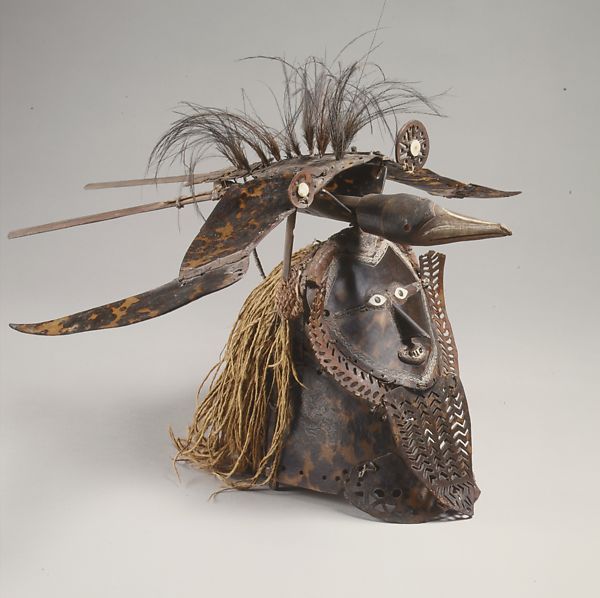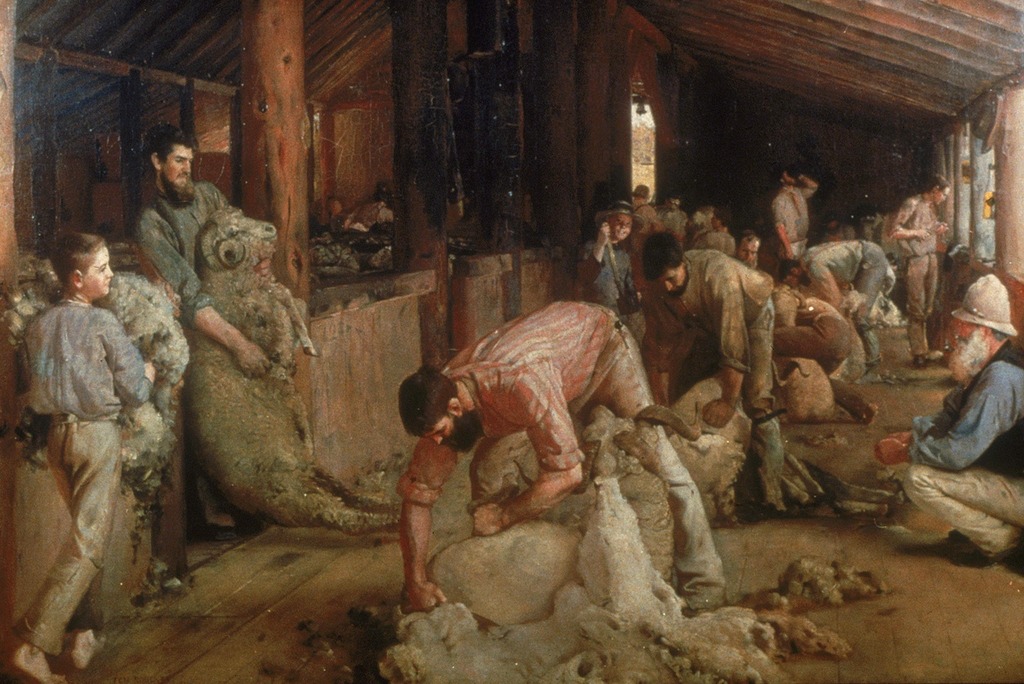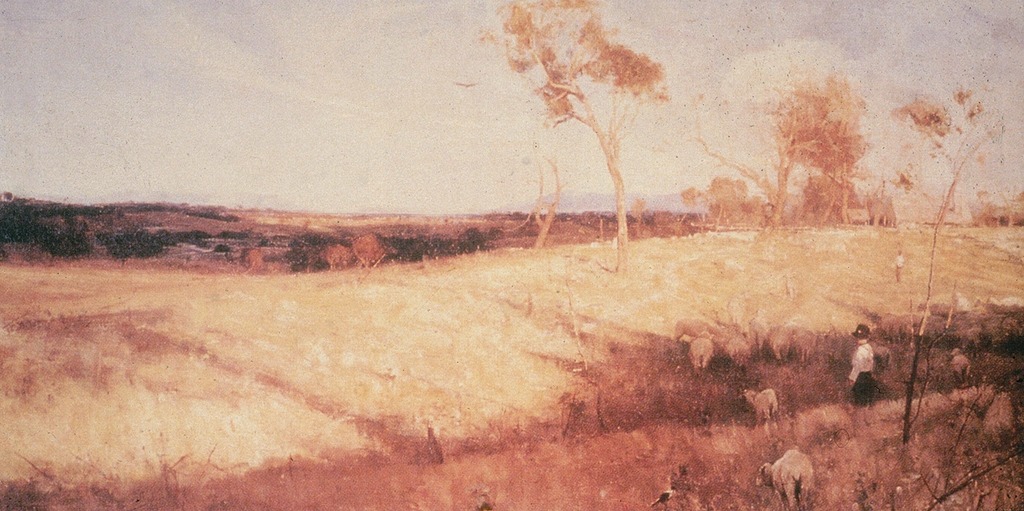Chapter 12.15: Australia
Aboriginal Australian Art
Aboriginal Australian art can be traced back at least 30,000 years and is one of the longest continuously practiced artistic traditions in the world.
Aboriginal and Indigenous Art
The visual arts have a long history in Australia, from ancient Aboriginal rock paintings to colonial landscapes to contemporary movements of today. Aboriginal art in Australia can be traced back at least 30,000 years; the rock art of Australian Aborigines is one of the longest continuously practiced artistic traditions in the world. Rock paintings are divided into three periods based on the styles and content of the art: the Pre-Estuarine Period (c. 40,000–6000 BCE), the Estuarine Period (c. 6000 BCE–500 CE), and the Fresh Water Period (c. 500 CE–present). There are also three regional styles of cave art:
- The geometric style (known for its concentric circles, arcs, and dots) found in Central Australia, Tasmania, the Kimberly, and Victoria;
- The simple figurative style found in Queensland; and
- The complex figurative style found in Arnhem Land.
Rock paintings are believed to have served several functions, from ceremonial to merely decorative. Today, they are preserved in national parks throughout the continent and protected through organizations such as the Friends of Australian Rock Art.

Influence of Aboriginal Art Today
The influence of Aboriginal artwork in Australia carries over to the 19th and 20th centuries in the works of William Barak, who recorded traditional aboriginal ways for the education of Westerners: Margaret Preston, a non-indigenous painter incorporating Aboriginal influences in her works; Albert Namatjira, an Arrernte artist whose landscapes inspired the Hermannsburg School of art; and Elizabeth Durack, notable for her fusion of Western and indigenous influences.
In 1971, Geoffrey Bardon encouraged the Aboriginal people of Papunya to paint their Dreamtime stories about creation, people, animals, and customs on canvas. This led to the development of the Papunya Tula School, or dot art, now possibly Australia’s most recognizable style of art worldwide. Clifford Possum Tjapaltjarri, Long Jack Phillipus Tjakamarra, and William Sandy are some of the best-known Papunya artists. Other Aboriginal artists have incorporated Western mediums into their work, such as Emily Kngwarreye, Rover Thomas, and Freddy Timms.
Video
Mask (Buk), Torres Strait, Mabuiag Island (4:42)
Colonial Australian Art
European colonization had a profound and permanent effect on the artwork of Australia.

Colonial Art (1770–1900) The visual arts have a long history in Australia, from ancient Aboriginal rock paintings to colonial landscapes to contemporary movements of today. Europeans depicted the natural landscape, plant life, and wildlife of the Australian continent during initial voyages in the late 1700s. John Lewin and Harriet and Helena Scott were among the first professional natural history illustrators, while artists such as Augustus Earle focused on ethnographic portraiture of Aboriginal Australians. The colonial art market primarily desired landscape paintings, which are often described as making a gradual shift from a European sense of light to a more Australian one. The lighting in Australia is notably different from that of Europe, and early attempts at landscapes attempted to reflect this. The art of this era is also characterized by transformation, where artistic ideas originating from beyond (primarily Europe) gained new meaning and purpose when transplanted into the new continent and the emerging colonial society.
Early Colonial Art (1770–1850) The first artistic representations of the Australia scene by European artists were mainly natural history illustrations, depicting the distinctive flora and fauna of the land for scientific purposes and the topography of the coast. Sydney Parkinson, the Botanical illustrator on James Cook’s 1770 voyage that first charted the eastern coastline of Australia, made a large number of such drawings under the direction of naturalist Joseph Banks. Until the turn of the century, all drawings made in the colony were crafted by soldiers, including British naval officers George Raper and John Hunter, and convict artists, including Thomas Watling. Most are in the style of naval draughtsmanship and cover natural history topics, specifically birds, while a few depict the infant colony itself.
Later Colonial Art (1850–1895) From 1851, the Victorian Gold Rush resulted in a huge influx of settlers and new wealth. S. T. Gill (1818–1880) documented life on the Australian gold fields; however the colonial art market primarily desired landscape paintings, which were commissioned by wealthy landowners or merchants wanting to record their material success. Some of the artists of note included Eugene von Guerard, Nicholas Chevalier, William Strutt, John Skinner Prout, and Knut Bull. Louis Buvelot was a key figure in landscape painting, illustrating a more domesticated and settled view of the land. Among the first Australian artists to gain a reputation overseas were the impressionist John Peter Russell and landscape painter Rupert Bunny.

The Heidelberg School (1885–1910) The origin of distinctly Australian painting is associated with the Heidelberg School of the 1880s–1890s. Like European Impressionists, artists such as Arthur Streeton, Frederick McCubbin, Tom Roberts, and Charles Conder applied themselves to recreating a truer sense of light and color as seen in the Australian landscape. They began an impressionistic plein air approach to the Australian landscape that remains embedded in Australia’s popular consciousness, both inside and outside the art world.
Their most recognized paintings involve scenes of pastoral and outback Australia. Central themes of their art are considered those of work, conquering the land, and an idealization of the rural pioneer. By the 1890s, most Australians were city-dwellers, and a romantic view of pioneer life gave great power and popularity to images of the rural landscape.

Media Attributions
- Figure 1. Aboriginal Rock Art, Ubirr Art Site, Kakadu National Park, Australia: Aboriginal art in Australia can be traced back at least 30,000 years (Image source: Luke Durkin via Wikimedia Commons) is licensed under a CC BY (Attribution) license
- Figure 2. Mask, Australia; Torres Strait, Mabuiag Island, 19th century, Turtleshell, wood, feathers, coconut fiber, resin, shell, paint (The Metropolitan Museum of Art; Image source: Artstor. Used with permission, for education use only)
- Figure 3. Tom Roberts, Shearing the Rams, 1890, oil on canvas. (National Gallery of Victoria; Image source: University of California, San Diego, via Artstor. Used with permission, for education use only)
- Figure 4. Golden Summer, Eaglemont (1889) oil-on-canvas, by Arthur Streeton: Artists such as Arthur Streeton (1867–1943) attempted to capture the unique golden light and color that characterize the Australian landscape (Image source: University of California, San Diego, via Artstor. Used with permission, for education use only)
Candela Citations
- Australia: Boundless Art History. Provided by: Lumen Learning. Retrieved from: https://www.coursehero.com/study-guides/boundless-arthistory/australia/. License: CC BY-SA: Attribution-ShareAlike

